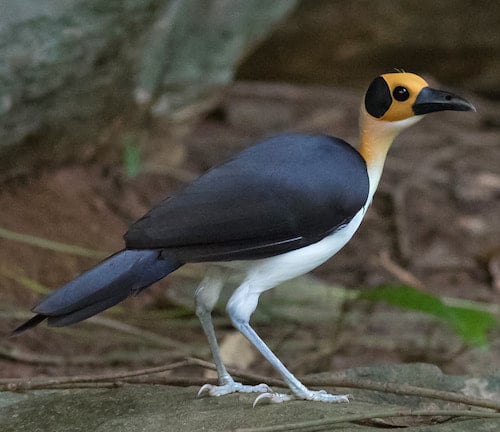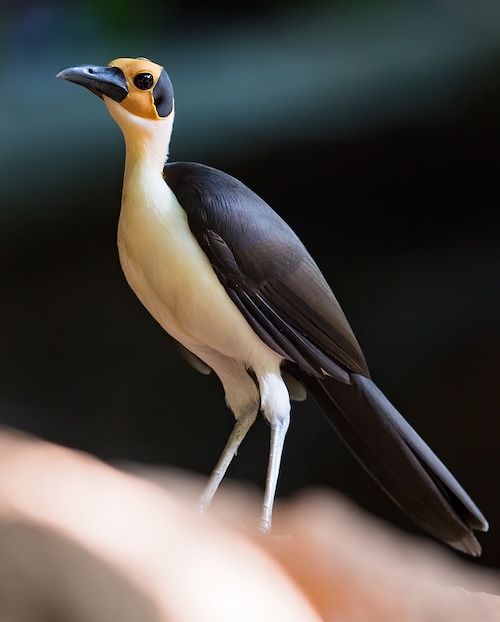Picathartidae – Rockfowl

Picathartes or Rockfowl (sometimes called bald crows) are a small genus of two passerine bird species forming the family Picathartidae, which in the taxonomic lists sits between Chaetopidae (Rockjumpers) and Petroicidae (Australasian Robins). They are found in the rain-forests of tropical west and central Africa.
They feed on insects and other invertebrates picked from damp rocky areas. Both species are totally non-migratory, being dependent on a specialised rocky jungle habitat, and both species are listed as vulnerable to extinction on the IUCN Red List.
The picathartes are large (33–38 centimetres long) passerines with crow-like black bills, long necks and legs. The two species are similar in appearance, both are long-tailed and have unfeathered heads. They weigh between 200–250 grams. The strong feet and grey legs are adapted to terrestrial movement, and the family progresses through the forest with long bounds on the ground. The wings are long but are seldom used for long flights. The plumage is similar between the two species, with white breasts and bellies and darker (grey and grey-black) wings, backs and tails. The neck colour varies between the two species, giving them their individual names (Grey-necked and White-necked Rockfowl). Their bald heads are brightly coloured with patterned skin.
They are generalised feeders, taking a wide range of invertebrate prey, which include a range of insects, particularly beetles, termites and ants, as well as millipedes, centipedes, earthworms and gastropods. Frogs and lizards are also taken, but these are mostly fed to their chicks. Prey is taken both by foraging on the ground and in the trees. They will also forage in shallow flowing water for crabs. When foraging on the ground, they move forward with hops and bounds, then pause to search for prey. The longish bill is used to turn over leaves and seize prey, but the feet are never used for either. Both species will follow swarms of ants in order to snatch larger prey fleeing the ants.

White-necked Rockfowl Picathartes gymnocephalus – ©Dubi Shapiro
Both species of rockfowl breed seasonally in the wet season. Where an area experiences two wet seasons in a year, they will breed twice in that year. Despite reports of cooperative breeding, it is now thought that they are exclusively monogamous, breeding in pairs. They are also commonly reported to be colonial, and will breed in colonies of up to seven pairs, but solitary breeders and smaller colonies of just two pairs are more common. The nest is made of mud attached to a cave roof or overhanging rock on a cliff. The nest is a cup-like structure of dried leaves, twigs and plant fibres set into dried mud. Two eggs are laid, 24 to 48 hours apart. Both parents participate in incubating the eggs, each taking 12-hour shifts before being relieved by their partner. It takes around 20 days for the eggs to hatch. Picathartes hatchlings are altricial at hatching, almost naked (a few feathers are present on the crown and back) and helpless. The chicks take around 25 days to fledge.
The rockfowl are distributed in west and western Central Africa, in Guinea, Sierra Leone, Liberia, Ivory Coast, Ghana (White-necked Rockfowl), Nigeria, Cameroon, Equatorial Guinea, Gabon, the Republic of the Congo and the Central African Republic (Grey-necked Rockfowl). They live in lowland rainforest at up to 800m, in rocky and hilly terrain on the slopes of hills and mountains. They require forest litter for foraging, a large enough area to contain army-ant swarms (Dorylinae), and rocks, cliffs or caves for nesting sites.
-
Number of bird species: 2
(As at July 2025)
The IOC recognise just two species in this family; they are:
White-necked Rockfowl Picathartes gymnocephalus
Gray-necked Rockfowl Picathartes oreas
-
Picathartidae
Family AccountPicathartids are monogamous with biparental care. They sometimes breed colonially, with up to 40 pairs at a single site... -
Picathartidae
Family AccountThe picathartes, rockfowl, or bald crows are a small genus of two passerine bird species forming the family Picathartidae found in the rain-forests of tropical...
-
Grey-necked Rockfowl Picathartes oreas
Species AccountFull species account… -
Grey-necked Rockfowl Picathartes oreas
Species AccountLarge bird with carmine, black and lilac head. Dark bluish-grey upperparts with silky grey throat and breast and yellow belly. -
Grey-necked Rockfowl Picathartes oreas
Species AccountSound archive and distribution map. -
Grey-necked Rockfowl Picathartes oreas
Species AccountThe grey-necked rockfowl (Picathartes oreas) is a medium-sized bird in the family Picathartidae with a long neck and tail. Also known as the grey-necked picathartes, this passerine is mainly found in rocky areas of close-canopied rainforest from south-west Nigeria through Cameroon, Equatorial Guinea, and south-west Gabon. -
White-necked Rockfowl Picathartes gymnocephalus
Species AccountLarge, unusual bird with brightly coloured, naked head. Bright, chrome-yellow and black head is diagnostic. Neck and underparts gleaming white with dark, bluish-grey upperparts and tail -
White-necked Rockfowl Picathartes gymnocephalus
Species AccountSound archive and distribution map. -
White-necked Rockfowl Picathartes gymnocephalus
Species AccountThe white-necked rockfowl (Picathartes gymnocephalus) is a medium-sized bird in the family Picathartidae, with a long neck and tail. Also known as the white-necked picathartes, this passerine is mainly found in rocky forested areas at higher altitudes in West Africa from Guinea to Ghana. Its distribution is patchy, with populations often being isolated from each other.
